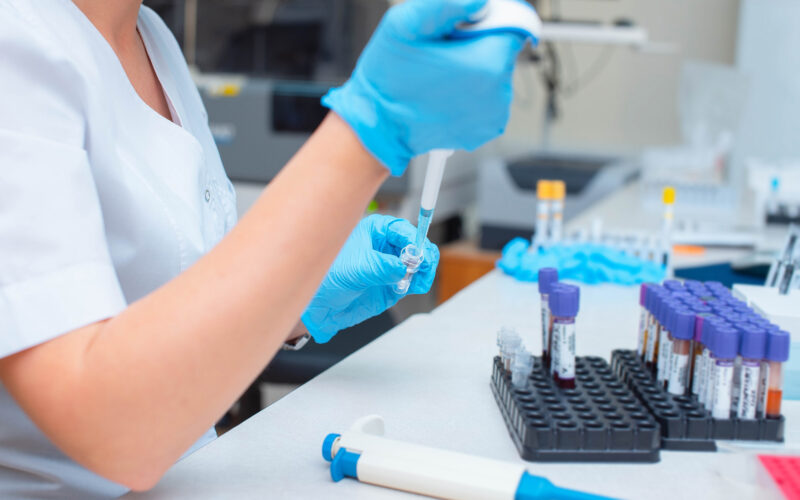Early on in my first pregnancy, my obstetrician suggested I have a newer form of prenatal genetic testing. The test, called non-invasive prenatal testing (NIPT), analyzes pieces of DNA from the pregnant mother’s bloodstream during the first trimester to determine the likelihood of her baby having certain genetic disorders.
Like any screening test, NIPT can give wrong results, and when I was pregnant I wanted to know how often that happened before agreeing to the test. But when I inquired, neither the obstetrician nor her nurse practitioner offered a response, instead deflecting and pressuring me to the point where I felt I had no choice. Their inability to answer that basic question, whether because they didn’t know the answer or because they felt for some reason that providing that information might dissuade me from choosing the testing, was disconcerting. (Although I was taken aback by the experience, I should not have been surprised, because evidence suggests that clinicians do a poor job of counseling women about prenatal testing and often fail to mention that any woman can decline testing [1].)
As it turns out, I was right to be skeptical about my need for prenatal genetic testing. A positive genetic screening test result, suggesting the baby has a disorder, can often be wrong, according to a recent bombshell report from The New York Times. (I say “suggesting,” because screening tests are not diagnostic, and therefore cannot tell you definitively one way or another whether your baby actually has the disorder for which he or she is being screened.) This is known as a false-positive result. False-positives are more likely to happen when the disorders being tested for are rare, when several are tested for at the same time, and when women who are not at risk for having a baby with a chromosomal disorder (like I was) are tested.
A negative result, suggesting the baby has none of the disorders tested, can also be wrong. This is called a false-negative. But because a false-negative does not cause nearly so much distress or anxiety during pregnancy, and generally leads to no further testing (whereas a false-positive would have follow-up testing), much of this article will focus on the problem of false-positive results from non-invasive prenatal testing can create.
What is non-invasive prenatal testing?
Typically, non-invasive prenatal testing (NIPT) is used to screen for disorders in which there is a missing or extra chromosome. Most often, the disorders tested are Down syndrome, Edward syndrome, Patau syndrome, Turner syndrome, Klinefelter syndrome, Triple X syndrome, and Jacob syndrome [2]. Tests can also screen for rarer chromosomal disorders and those in which small pieces of chromosomes are missing, known as microdeletions.
When NIPT first became available a decade ago, it was mainly used for pregnant women who had a high risk for having a baby with a chromosomal disorder [3]. For example, pregnant women over the age of 35 have an elevated risk because of their age. As of 2020 though, the American College of Obstetricians and Gynecologists recommends that all pregnant women be offered NIPT, regardless of their risk.
The test itself poses no risk to the mother or her baby and is a welcome alternative to invasive prenatal genetic tests like chorionic villus sampling and amniocentesis, because both have a risk of miscarriage. NIPT results are generally characterized as “positive” or “negative,” but sometimes no result is given because not enough DNA was found in the bloodstream.
Because NIPT is merely a screening test, it can only tell you whether your baby potentially has, or does not have, a genetic disorder. In more blunt terms, the test results can be wrong, and often are, as evidenced by the NYT report. While amniocentesis is the only prenatal test that can tell you with near certainty your baby’s health, only waiting until your baby is born can tell you for sure.
So, how often are these prenatal test results wrong?
Oftentimes, testing is described as 99% accurate—which sounds incredibly impressive—but this is misleading and doesn’t tell you the odds that your positive result is actually right [4]. Researchers in the United Kingdom recently helped break this down for three disorders routinely tested for—Down syndrome, Edward syndrome, and Patau syndrome—by analyzing data from several studies.
What the researchers found was stunning: They estimate that, if you are at high risk, a positive result for Down syndrome is correct 91% of the time and wrong 9% of the time [4]. That means one in ten women who receive a positive result suggesting her baby has Down syndrome will go on to have a baby without the condition.
Beyond Down syndrome, which is the most common chromosomal disorder, testing accuracy falls, even for high-risk women, because the chromosomal disorders tested for are far less common. For instance, an estimated one in six high-risk women who learn their baby may have Edward syndrome will give birth to a baby without the condition [4]. Similarly, one in eight high-risk women who receive a result that indicates Patau syndrome will go on to have a baby free from the condition.
NIPT is less accurate for women in low-risk category for chromosomal disorders
The researchers from the United Kingdom also found that the proportion of false-positives is particularly high for women who are not high risk (more on who is considered high-risk here), which is most women. For that reason, other experts have cautioned against offering the test to this group of women [3].
For women who are not high risk, it’s estimated that a positive result for Down syndrome turns out to be wrong for one in five women, and a positive result for Edward syndrome or Patau syndrome is wrong more often than it is right [4]. And these three conditions—Down syndrome, Edward syndrome, and Patau syndrome—are arguably the ones that can be detected with the most accuracy.
NIPT is wrong “most of the time” for these disorders–but why?
The analysis by the New York Times mentioned above found that tests that look at particularly rare chromosomal disorders are wrong most of the time. Other researchers have warned this would happen, even for chromosomal disorders that are more common [5]. The U.S. Food and Drug Administration is now warning women about the possibility of incorrect results and inappropriate interpretation of the results.
But why are these tests so inaccurate? The high rate of false-positives is somewhat expected when testing for very rare conditions. But there are a few other possible explanations [6]. For example, because this test is performed by humans, a laboratory error can occur. Additionally, if the pregnant mother herself has a chromosomal disorder but is unaware of it, that too can give a false-positive result.
Where the DNA comes from matters too. The pieces of DNA in the mother’s bloodstream that are tested actually come from the placenta, which has nearly the same DNA as the unborn baby because they originate from the same cells. But, about 1 to 2 percent of the time, the placenta has a different number of chromosomes while the baby has the correct number, a phenomenon known as confined placental mosaicism. When that happens, a test can show that the baby has a disorder but in reality he or she is perfectly fine. It’s just the placenta that has the wrong number of chromosomes. For that reason, invasive testing with chorionic villus sampling, which tests DNA from the placenta, can give wrong results, and test results from chorionic villus sampling should never be considered diagnostic.
Wrong NIPT results can prompt anxiety—or worse
Because NIPT could only tell me whether my baby potentially had a disease, and a positive result would only cause anxiety for months to come, I knew it wasn’t the right test for me, despite the pressure I felt from my doctor. Pregnant mothers should always be properly counseled before and after NIPT. They should be counseled that they have a choice whether to undergo testing, and cautioned that test results can be inaccurate for various reasons.
However, one study found that, even with counseling, some women ended their pregnancies when testing revealed that their babies could have a disorder [7]. This should never be done, both because the results can very well be wrong and because abortions themselves come with risks, potentially affecting future pregnancies by putting women at higher risk of preterm birth [8]. Again, the only way to know for certain whether your baby actually has one of these disorders is to wait for the baby to be born.
A note about the risks of amniocentesis
Another reason I declined NIPT was because the only way to relieve my anxiety during pregnancy (should I receive a positive result from NIPT) would be to have an amniocentesis.
During an amniocentesis, a thin needle is inserted into the pregnant woman’s uterus to collect amniotic fluid. That fluid is then tested for various disorders. But amniocentesis comes with a risk of miscarriage and can sometimes be wrong, too (either in the form of false-negative or false-positive results) though how often that happens in unclear [9].
While miscarriage rates with amniocentesis are less than one percent in the United States, experts warn that the rates could rise as NIPT becomes more popular, and less invasive testing is done to the point that clinicians lose their skills for performing more invasive procedures [10]. Remember, before NIPT became available, invasive testing options (like amniocentesis) were the only option, and clinicians routinely performed these tests.
Refusing NIPT doesn’t mean you’re flying blind—a routine ultrasound at 20 weeks can reveal much about your baby’s health
In the end, I declined NIPT during my pregnancy. And, for reasons unrelated to my poor experience (we moved) I ended up switching obstetricians part way through my pregnancy. Oh, the difference that made!
The doctor who saw me through the rest of my pregnancy never pressured me to have NIPT. I learned from that doctor, too, that the ultrasound scan done around week 20 of pregnancy, commonly called the anatomy scan, can reveal much about your baby’s growth and development and even identify birth defects, which babies with chromosomal disorders often have [11].
Of course, an ultrasound is also a screening test, and cannot tell you for sure whether your baby has a disorder. Again, you’ll have to wait until the baby is born for any definitive diagnosis. Still, ultrasound can provide some peace of mind and it has a lower false-positive rate than non-invasive prenatal testing [12].
Certainly, wanting to know as much as possible about a child’s health challenges ahead of time is understandable, and can give parents time to prepare to meet their child’s unique needs. But prenatal testing can still only give limited information, and especially for women who are not at high-risk, these tests may induce unnecessary anxiety and heartbreak. Furthermore, as writer Amy Julia Becker (who has a daughter with Down syndrome) noted in a recent op-ed for the New York Times:
“The assumptions behind our prenatal testing programs also condition parents—and society as a whole—to see our kids as valuable according to their physical strength, intellectual capacity and social acuity rather than setting us up to receive their lives as they are given.”
Prenatal genetic tests, if accurate, can tell what’s medically wrong, but they are no crystal ball into the future. And they cannot tell what good is coming, what joy and light that unique child will bring into the world.
References:
[1] Colicchia LC, et al. “Patient-Health Care Provider Conversations About Prenatal Genetic Screening: Recommendation or Personal Choice.” Obstetrics and Gynecology, vol. 127, no. 6, 2016, pp. 1145-1152. DOI: 10.1097/aog.0000000000001433. PMID: 27159763; PMCID: PMC4879044. [2] Ravitsky, Vardit et al. (2021). “The Emergence and Global Spread of Noninvasive Prenatal Testing.” Annual Review of Genomics and Human Genetics, vol. 22, 2021, pp. 308-339. https://doi.org/10.1146/annurev-genom-083118-015053 [3] Labonté, Valérie et al. “Psychological and Social Consequences of Non-invasive Prenatal Testing (NIPT): a Scoping Review.” BMC pregnancy and childbirth, vol. 19, no. 1, 2019, pp. 385. doi:10.1186/s12884-019-2518-x. [4] Taylor-Phillips, Sian et al. “Accuracy of Non-invasive prenatal Testing Using Cell-free DNA for Detection of Down, Edwards and Patau Syndromes: a Systematic Review and Meta-analysis.” BMJ open, vol. 6, no.1, 2016, e010002. doi:10.1136/bmjopen-2015-010002. [5] Thomas, Joseph et al. “Non-invasive Prenatal Testing: Clinical Utility and Ethical Concerns about Recent Advances.” Med J Aust, vol. 214, no. 4, 2021. doi: 10.5694/mja2.50928 [6] McCullough, RM. et al. “Non-Invasive Prenatal Chromosomal Aneuploidy Testing- Clinical Experience: 100,000 Clinical Samples.” PLOS ONE. 2014. https://doi.org/10.1371/journal.pone.0109173 [7] Dobson, Lori J. et al. “Patient Choice and Clinical Outcomes Following Positive Noninvasive Prenatal Screening for Aneuploidy with Cell-Free DNA (cfDNA).” Prenatal Diagnosis, vol. 36, no. 5, 2016, pp. 456-462. doi:10.1002/pd.4805 [8] Magro Malosso, Elena Rita et al. “US trends in abortion and preterm birth.” The journal of maternal-fetal & neonatal medicine : the official journal of the European Association of Perinatal Medicine, the Federation of Asia and Oceania Perinatal Societies, the International Society of Perinatal Obstetricians vol. 31, no. 18, 2018, pp. 2463-2467. doi:10.1080/14767058.2017.1344963. [9] Alfirevic, Z et al. “Amniocentesis and chorionic villus sampling for prenatal diagnosis.” The Cochrane database of systematic reviews, vol. 3, 2003, CD003252. doi:10.1002/14651858.CD003252 [10] Hui., L et al. “How to Safeguard Competency and Training in Invasive Prenatal Diagnosis: ‘The Elephant in the Room.’” Ultrasound Obstet Gynecol, vol. 47, no. 1, 2016, pp. 8–13. https://doi.org/10.1002/uog.15806. [11] Karim, J N et al. “Systematic review of first-trimester ultrasound screening for detection of fetal structural anomalies and factors that affect screening performance.” Ultrasound in obstetrics & gynecology : the official journal of the International Society of Ultrasound in Obstetrics and Gynecology vol. 50, no. 4, 2017, pp. 429-441. doi:10.1002/uog.17246 [12] Debost-Legrand, A. et al. “False Positive Morphologic Diagnoses at the Anomaly Scan: Marginal or Real Problem, a Population-based Cohort Study. BMC Pregnancy Childbirth, vol. 14, no. 112, 2014. https://doi.org/10.1186/1471-2393-14-112







Christina does a better job explaining this than the NYT article did, however, I would not call the NYT article a bombshell. It made me livid. Why? I’ll get to that later. I am a Catholic genetic counselor and spent almost 20 years of my career in prenatal genetics. I even worked at a place that was involved in developing prenatal screening tests a long time ago. I myself had a baby at 37 and declined prenatal screening and testing – just in case anyone already made an assumption about my reason for these comments. The most important things I want to comment on are like Christina explained NIPT is a SCREENING test. It provides a RISK – like 1 in 10 for Trisomy 21, 13, 18 etc…. And a 1 in 10 risk means a 90% chance that doesn’t happen. So, to make comments like “these test results are wrong most of the time” is irresponsible. Think of Pap smears. They are also screening tests. Most of the time when they return “screen positive” further testing is done (colposcopy) and those results show that everything is fine. That is the nature of screening tests. Then why develop or do screening testing? Because they are ways to find people who are at risk for X,Y, or Z that are low risk and inexpensive – because we are offering them to populations. Then based on those results we go on to identify individuals who may want to have diagnostic testing. Amniocentesis in this case is the diagnostic testing. If someone wants to know for example, if their baby has Down syndrome, to prepare for that, then amniocentesis provides that answer. It is accurate and for something like Down syndrome (Trisomy 21), Trisomy 18 (Edward syndrome) or Trisomy 13 (Patel syndrome) it’s just about 100% because it literally is testing the baby’s chromosomes. The risk for amniocentesis exists and is small if done in the right hands (less than .5% or 1 in 200; by a perinatologist). In 16 years I never saw 1 loss or complication from amniocentesis done in the hands of a perinatologist. For some people, they need to know – especially for example, if the baby has a finding on the ultrasound such as a heart defect. Now the risk for a chromosome abnormality is higher than the risk for from an amniocentesis and it could be important information for preparing for birth with the best possible outcome (prenatal consultation with pediatric cardiology, delivery planned at a place with access to what the baby will need….). The discussion in this article about people being at risk or not being at risk is misleading. Everyone is at risk of having a baby with Down syndrome by virtue of being pregnant. Age increases that risk – but smoking and alcohol use and pre-existing health conditions – do not increase a woman’s chance for having a baby with a chromosome abnormality – other things maybe (fetal alcohol syndrome, low birth weight, preterm delivery….). Age or family history are the factors that increases a person’s chance for having a baby with a chromosome abnormality. Why did prenatal screening start? Because if they offered testing like amniocentesis to everyone 35 and over (which used to be the case) – they would miss finding MANY babies with Down syndrome because they are not only born to women over 35. Many doctors, nurses do not explain screening tests well and do not make people feel like they can decline them. I myself had to sign a form saying I declined and understood my risk for a chromosome abnormality at my age. Why? Because of lawyers and women who have sued their doctors because they had a baby with a chromosome abnormality and stated that their doctor didn’t make them understand their risk. Prenatal screening is SCREENING – it is NOT DIAGNOSTIC TESTING. It is a tool to help identify people who are at increased risk who otherwise would not know that – it is also a tool to help women who are considered at risk based solely on age – have more Information that can reduce their risk and alleviate some anxiety. If understood and used in conjunction with a good ultrasound (18-20 week morphology scan) – these screening tests do significantly decrease the number of amniocenteses done, decreasing costs and risks to the pregnancy and decreasing anxiety for many. If a persons screening test increases their risk then of course anxiety is increased – just like it is if we have positive Pap smears or mammograms – but it’s important to understand that it is a screening test. I would say I’ve never seen nor do I know a doctor that would allow for or perform a pregnancy termination for a screening test result. Just like no doctor would do chemotherapy for breast cancer based on the results of a mammogram. People need to understand that they can decline screening. People need not be coerced into screening. It needs to be better understood. It has been misunderstood for more than 30 years. I have heard a thousand times “they told me/my sister/my friend that the baby had Down syndrome and he was born perfectly fine” when in fact they actually only had an increased risk for Down syndrome and never had diagnostic testing. If understood and used properly for counseling about RISKS – then screening testing is a tool that can help alleviate anxiety for many IF THEY CHOOSE TO HAVE IT or can find people who may be at risk who want to know that. Does a screen positive test cause anxiety? Yes – but if someone understands what they are choosing to do when they opt for screening then it can help. Reality is simply that more education is needed for the people (doctors, nurses) that give the option of these screening tests and give the results of these screening tests. Patients need to think very carefully about whether or not they want this information. If they know they would decline diagnostic testing like amniocentesis if they were told they have an increased risk based on the screening test – they might want to decline prenatal screening – especially if their anatomy ultrasound is normal – and save themselves from potential increased anxiety – that’s exactly what I did when I was pregnant at 37 – but I understood all of this intricately because it was my job.